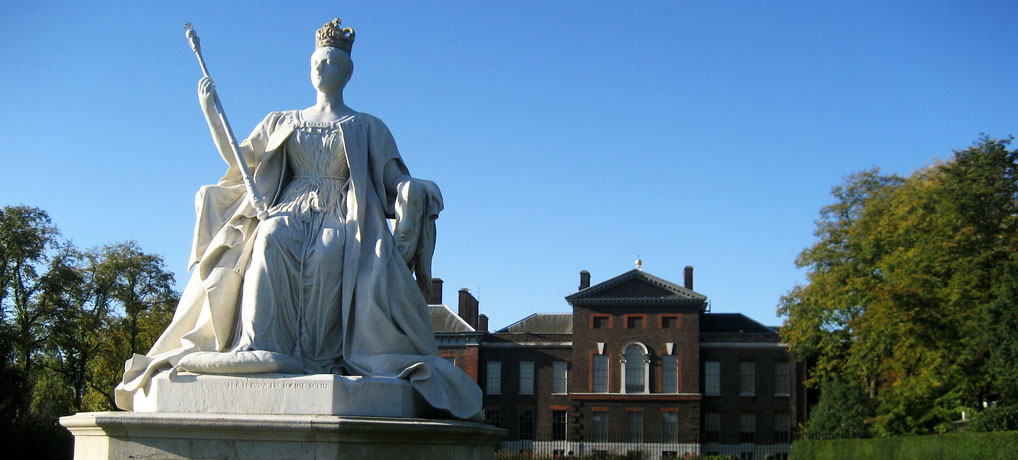
Queen Victoria born 24 May 1819; ascended to throne of the United Kingdom of Great Britain and Ireland 20 June 1837; died 22 January 1901.
The Duke and Duchess of Kent’s only child, Alexandrina Victoria, was born at 4.15 am on 24 May 1819. She was christened privately by the Archbishop of Canterbury, by the name of Alexandrina Victoria, in the Cupola Room at Kensington Palace where she was born,. The reason of the choice of these two names is explained: it was believed the Duke of Kent wished to name his child Elizabeth, that being a popular name with the English, but the Prince Regent (later George IV), who was not kind to his brothers, gave notice he should stand in person as one godfather, and that the Emperor of Russia was to be another. At the baptism, when asked by the Archbishop of Canterbury to name the infant, the Prince Regent gave only the name of “Alexandrina”’ but the duke requested that one other name might be added: “Give her her mother’s name also, then; but it cannot precede that of the Emperor.” The Queen, on her accession, commanded she should be proclaimed only as “Victoria.”’
At birth, Victoria was fifth in the line of succession to the throne, after her father and his three older brothers. On the death of her uncle George IV in 1830, she became heiress presumptive to her next surviving uncle, William IV. The Regency Act 1830 made special provision for her mother the Duchess of Kent to act as regent in case William died while Victoria was still a minor. King William distrusted the Duchess’s capacity to be regent, intensely disliked her advisor, Conroy, and in 1836 declared in her presence that if for no other reason he wanted to live until Victoria’s 18th birthday, so a regency could be avoided.
Kensington Palace was where Victoria spent nearly all her infancy, and the greater part of her youthful days. In the Gardens, as a child, the Princess Victoria used daily to take her walk, or ride in a goat or donkey carriage, attended by her nurses.
On the 20th of June 1837, following, only a month after attaining her majority at eighteen, she was waited upon early in the morning by the Archbishop of Canterbury, and the Lord Chamberlain, the Marquis of Conyngham. They reached Kensington Palace about five; they knocked, they rang, they thumped for a considerable time before they could rouse the porter at the gate; they were again kept waiting in the court-yard; they turned into one of the lower rooms, where they seemed forgotten by everybody. They rang the bell, desired that the attendant of the Princess Victoria might be sent to inform Her Royal Highness. they requested an audience on business of importance. After another delay, and another ringing to inquire the cause, the attendant was summoned, who stated that the Princess was in such a sweet sleep she could not venture to disturb her. Then they said, “We are come to the Queen on business of state, and even her sleep must give way to that.” It did; and, to prove that she did not keep them waiting, in a few minutes she came into the room in a loose white nightgown and shawl, her nightcap thrown off, and her hair falling upon her shoulders, her feet in slippers, tears in her eyes, but perfectly collected and dignified.
The young Queen met the council at Kensington Palace at eleven. Never was anything like the first impression she produced, or the chorus of praise and admiration which is raised about her manner and behaviour, and certainly not without justice. The Queen entered, and then read her speech in a clear, distinct, and audible voice, and without any appearance of fear or embarrassment; she read the declaration which the sovereign makes on coming to the throne, and took the oath to govern the realm according to law, and cause justice to be executed in mercy. She was quite plainly dressed, and in mourning.
Victoria moved from Kensington to Buckingham Palace, and Kensington Palace, where she was born and lived the first 18 years of her life fell into neglectful disrepair, to be described as, :nothing but bare walls and bare boards.” There was some thought of demolishing it, or turning it to public use as a gallery or museum. In 1898 a compromise was reached, it would be renovated and maintained at public expense, but with the exception of private residences within the Palace, it would be open to public view. An attempt was made to restore the State Rooms to the condition at the time of George II, and in May 1899, Queen Victoria’s 80th birthday Kensington Palace was opened to public view, the Queen has furnished paintings and objects to heighten interest in the history of the Royal Family and the development of the British Empire.
Though no longer used as a royal residence, apartments in Kensington Palace were appropriated to the use of certain pensioned families, favoured by royalty, known as Grace and Favour residences.
